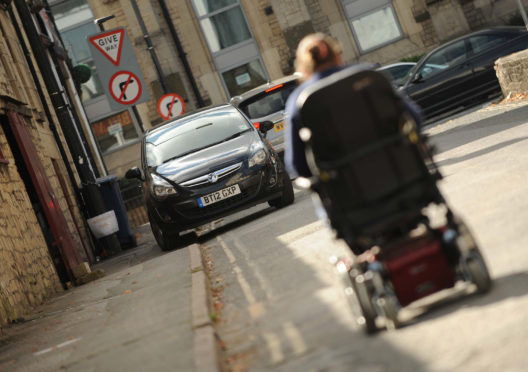For many years I’ve been an advocate for banning obstructions and vehicles parking on pavements.
I ran a campaign in my Grampian Regional Council days to keep pavements clear for pedestrians. I raised the issue when I saw a young mum pushing a baby in its buggy, stepping off the pavement and directly into a bus lane because the pavement was full of advertisement boards and various bits of street furniture blocking her way.
Fortunately nothing bad happened – but thoughtlessness on the part of those placing tables, chairs and billboards on the pavements could have been tragic.
My concerns were also for visually-impaired people who were unable to see the obstructions. Certainly, anyone in a wheelchair would also have been forced onto the busy road.
After much consultation and debate the Grampian Regional council issued leaflets to all shop owners reminding them to keep all obstructions off the pavements unless planning permission had been given. This seemed to have worked for a spell until the councils were reorganised and Aberdeen City came into being. Since then there has been a lack of action to enforce the rules on pavement obstructions.
It is remarkable that no rogue cyclist has been charged with cycling on the pavements – despite the fact it’s illegal (except where the council has authorised it.) Cycling and skateboarding is also a serious threat to pedestrians on our pavements. People with visual impairments or hearing difficulties are often taken by surprise when a skateboard or cyclist races past them.
But the one thing I never got anywhere with was cars and other vehicles which were parked on the pavements. It cost the council almost £1 million per year of your money to repair and replace damaged pavements.
The legal position was complex in that if a person was seen to drive onto the pavement they could be charged. But a vehicle parked on the pavement was not in itself a crime.
Other national organisations and charities also became involved in order to lobby for changes to what was very ambiguous legislation.
Well, it was with great pleasure that in Scotland from 2021 this will indeed be a criminal offence to even partially park on pedestrian footways.
The Transport (Scotland) Bill has passed and is awaiting Royal Assent.
However, there are some strange exemptions. Obviously the police, ambulance, fire and rescue vehicles can park on the pavement, when there is a risk to life.
But I am less clear as to why delivery and loading vehicles will be allowed a 20 minute exemption to park on the pavements.
Given that part of the legislation is to help councils with excessive costs for repairing damaged pavements caused by vehicle pavement parking, it seems to me an odd exemption, as these heavy vehicles will cause much more damage than a car.
Another controversial part of the bill is to allow councils to charge employers for workplace car parking. This idea was first floated by Henry McLeish when he was first minister of Scotland but never pursued. But now there is new legislation available, should councils choose to implement it.
It is unlikely to be taken up though as elected members are nervous about implementing anything that might be unpopular with the electorate.
As far as I’m aware, the only city in the UK which has actually imposed workplace parking is Nottingham. They charge £415 per parking space each year. The money it generates (about £64m) is invested in public transport which includes trams, modern buses and railway station improvements. Currently, in Scotland, only Glasgow and Edinburgh are actively considering the work place parking levy.
It does seem a bit unfair that if your employer provides you with a free parking space and you are not an essential car user, then that’s clearly a perk of your job which no one else gets. Others have to pay the cost of parking every time they drive into the city to work, or spend their money.
Aberdeen needs to decide whether they want to keep cars out of the city, or build more car parks to accommodate the number of single occupancy vehicles creating congestion and pollution on a daily basis.
More publicity needs to be given to car sharing and car pool hire schemes which would reduce the traffic congestion at various pinch points. And there seems little point in increasing car parking charges when so many areas within the city allow cars to park freely.
Park and Ride schemes are poorly attended and sometimes, despite good facilities, they are not properly staffed. More modern buses with appropriate access and lower fares might help too.
Advertising and encouraging local employers to make use of these facilities would be beneficial.
So, much to consider by the city council when drawing up a transport policy. Over the years I believe we have provided too much carrot and not enough stick.
Whatever position the Council adopts it will be unpopular. No one wins when dealing with transport.
However I guess until the convenience of the bus matches the comfort and convenience of the car, transport policy in Aberdeen city will remain firmly parked in the valley of indecision.
Len Ironside is a former champion wrestler who served as an Aberdeen councillor for 35 years, four years as council leader











